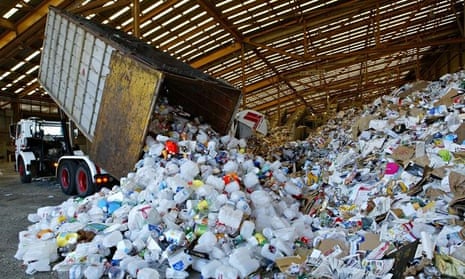The global plastics industry generates over 280m metric tons in waste every year (pdf). The majority ends up in landfills, incinerators or as marine and land litter.
The US Environmental Protection Agency estimates that 32m tons of plastics waste were generated in 2012, with only about 9% recovered for recycling (collected, sorted, baled and sold). Actual recycling rates are even lower because not everything in the bales is recycled. This is especially true with mixed plastic bales, which are mostly sent to developing countries for “low-cost” recycling.
And this is not just an issue of waste or disposal. These environmental health and safety practices impact workers and local ecosystems. The by-products and waste from these processors are often disposed of in ways that would be considered illegal in the countries where the waste originated, including dumping into “self-cleaning” streams that eventually find their way into oceans.
Following in the footsteps of steel
Plastics are much more valuable by weight than steel, which has an extremely high recycling rate. Interestingly, virgin steel companies often said that steel recycling would never expand beyond “downcycling” – a method of recycling that involves breaking an item down into its component elements or materials – into applications like reinforcing bars. Today, however, the biggest steel companies in the US are based on mini-mills and recycled steel. According to the Institute of Scrap Recycling Industries (ISRI), “steel produced by predominantly scrap-fed electric-arc furnaces accounted for more than 60% of the total raw steel produced in the United States in 2013.”
Plastics, an even more versatile material than steel, could follow the same trajectory and for the same reasons. Why don’t more US recycled material processors build the capacity to intercept this material and process it more responsibly in the US?
One of the challenges is the lack of a large domestic market for buyers of scrap plastics who want supplies that are reliable and consistent in both volume and quality, and collectors, generators and recyclers who want a reliable market that can create sufficient value to cover their costs and provide an attractive return on their investment.
In fact, while US material recovery facility operators demand long-term supply agreements often extending from 10 to 20 years from local municipalities before they make investments in their material recovery facility (MRF) operations, they remain reluctant to sign long-term supply agreements with their customers on the other side of their businesses, preferring to rely instead on a “trading to the highest bidder” model.
This reluctance continues, even with the slowdown in export markets for mixed plastic waste and the fact that their trading models have recently turned against them.
New economic opportunities
So how do we change this situation? First, let’s get past the fear of raising our waste management costs. Responsible waste management and scrap export polices across Europe and other regions are creating jobs and promoting domestic economic development directly via their processing plants, and indirectly by providing sources of post-consumer recycled materials to domestic manufacturers.
Some waste management companies suggest that increased recycling mandates will increase waste management costs. While such mandates might increase investment requirements, numerous studies have found that larger overall economic benefits can be realised by promoting recycling. After years of implementing and optimising very large recycling programs across Europe, the European Union has seen so many benefits that it is pushing even more aggressive recycling targets and promoting it as a critical part of its overall determination to develop a robust and more resilient circular economy.
As You Sow estimates that over $11bn (£7bn) of recyclable materials are wasted annually in America alone, making opportunities in the US huge. The US Environmental Protection Agency, among other US organisations, has produced studies highlighting significant economic advantages to be realised from recycling materials from our waste streams compared to disposal, including Recycling is Working (pdf) and Recycling Means Business (pdf).
Plastic recycling needs financing and assurance of supply
Initiatives such as the Closed Loop Fund, which has brought key business leaders together in a commitment to increase recycling across America, have potential not only because they elevate industry-wide collaboration on a key infrastructural issue, but because they target a national issue from a market standpoint. By addressing the issue of access, the fund is creating a systemic change that can, if applied and invested in strategically, be relied on to replicate and scale effectively.
The other critical factor required to encourage businesses to make substantial investments in domestic recycling infrastructure is feedstock security, and material recyclers need a similar assurance of supply required by waste management companies for the same reasons.
Without availability of financing and assurance of supply (which helps make the financing more secure), we will continue to see many of our valuable resources buried, burned or shipped overseas for “low-cost” informal recycling. And we will fail to realise the full potential of the economic, environmental and societal benefits associated with moving to a more circular economy.
The circular economy hub is funded by Philips. All content is editorially independent except for pieces labelled ‘brought to you by’. Find out more here.
Join the community of sustainability professionals and experts. Become a GSB member to get more stories like this direct to your inbox.

Comments (…)
Sign in or create your Guardian account to join the discussion